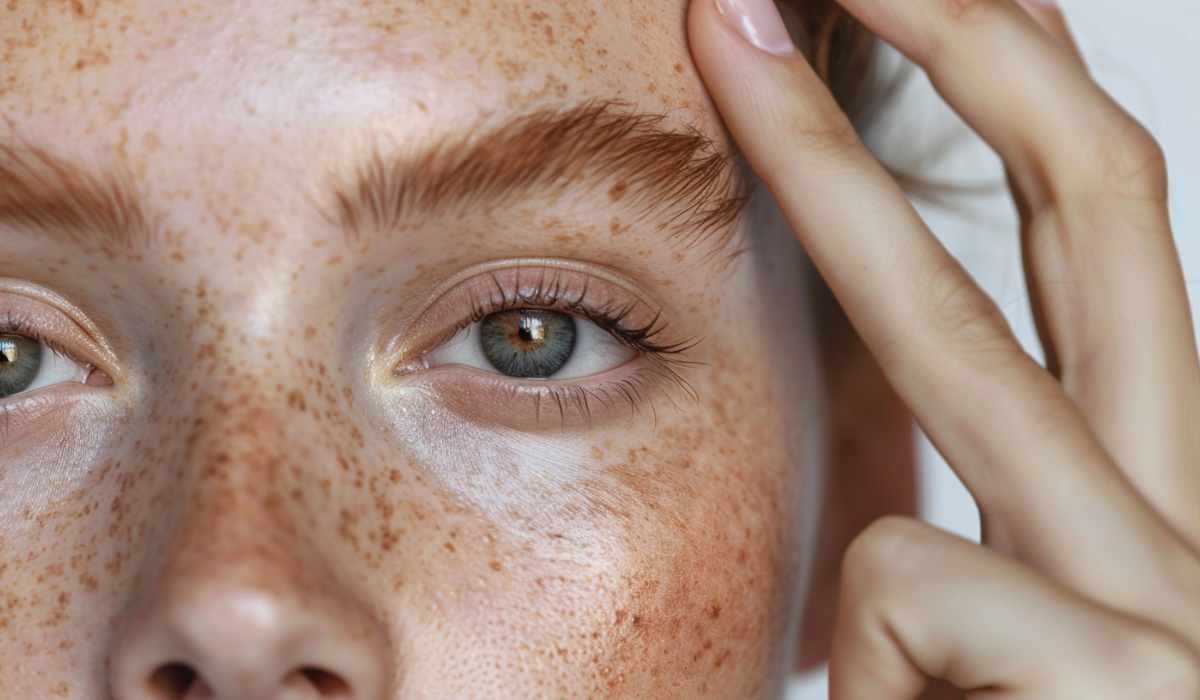3 VERY Natural Oils for the Different Types of Hyperpigmentation (A Very Simple Guide to Follow)
As someone deeply passionate about natural skincare, I’ve discovered that nature offers some of the best solutions for hyperpigmentation.
Did you know that certain oils, specifically rosehip, carrot seed, and tamanu, are WONDERFUL for hyperpigmentation? They not only penetrate the skin deeply but also work wonders in fading dark spots, promoting cell turnover and acting as natural antioxidants.
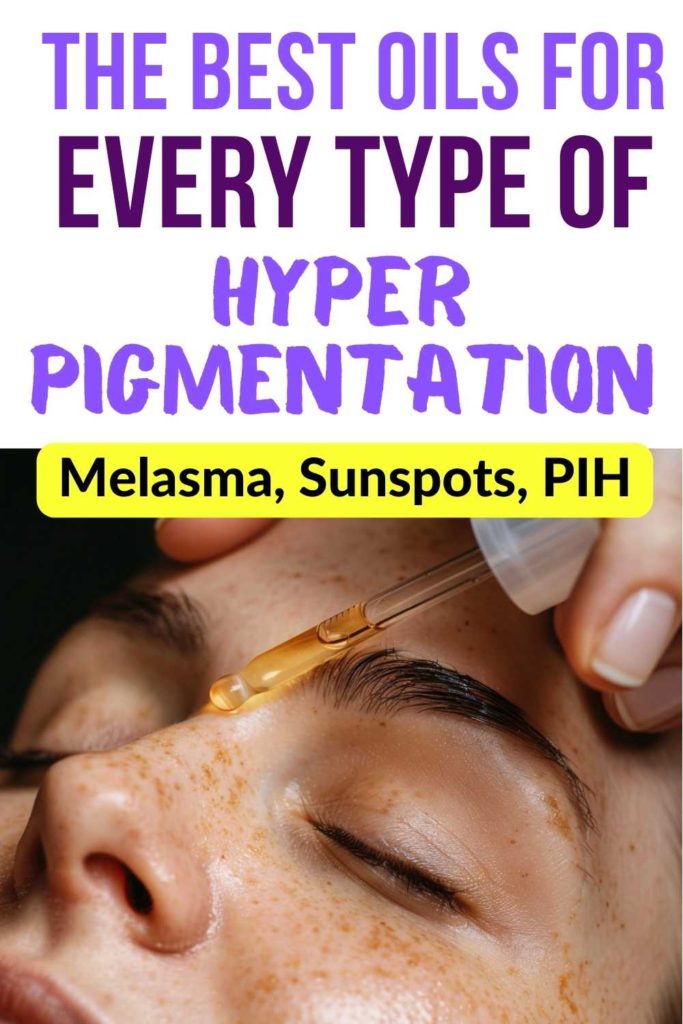
Hyperpigmentation, whether it’s melasma, sunspots, or the marks left by past blemishes, needs a personalised approach. That’s where these lovely oils step in.
Beware, they’re not just any oils – they’re packed with healing power to bring back your skin’s natural glow (I will explain everything below).
As a certified organic formulator that uses these types of ingredients all the time I can assure you these oils can help you. Please, give them a chance.
(Results can vary depending on each individual).
Yes, below I link to affiliate products and I might earn a commission but please note if you were to purchase they would not cost you any extra!
So, you have hyperpigmentation, I hear
Seeing dark patches on your skin can be disheartening, but you’re not on your own.
Hyperpigmentation is a common concern many of us face, especially with age, often worsened by UV exposure which accelerates skin discolouration. For years, I’ve turned to a natural regimen of oils and home-grown aloe vera to combat this. To my surprise, the hyperpigmentation didn’t just fade—it was completely eradicated. Contrary to my expectations of a long journey, one day, it simply vanished.
Yes, nature has blessed us with potent remedies that provide a gentle, yet effective, approach to dealing with skin concerns. Aren’t we lucky?!
The idea is to lighten those dark patches without harsh chemicals. These oils can work in harmony with your skin. Your skin understands natural!
First, about preventing hyperpigmentation
We should cover prevention first.
Preventing hyperpigmentation is simpler than you might think. Here’s how:
- Sun protection is crucial – always wear sunscreen. Natural please! (with zinc oxide or titanium dioxide).
- Use natural oils like the ones below; they’re your natural sun defenders and help renew skin.
- Don’t pick at your skin; it can lead to more dark spots.
- Include antioxidants in your skincare to fight damage.
- Stay hydrated to keep your skin healthy and glowing.
Adding the right foods can also play a key role in preventing hyperpigmentation. Here’s a quick guide:
- Eat Vitamin C-rich fruits like oranges and berries – they help brighten your skin.
- Incorporate leafy greens into your diet; they’re full of antioxidants.
- Omega-3 fatty acids like flaxseed and chia seeds can reduce inflammation.
- Nuts (and seeds) are great for their vitamin E, protecting skin from damage.
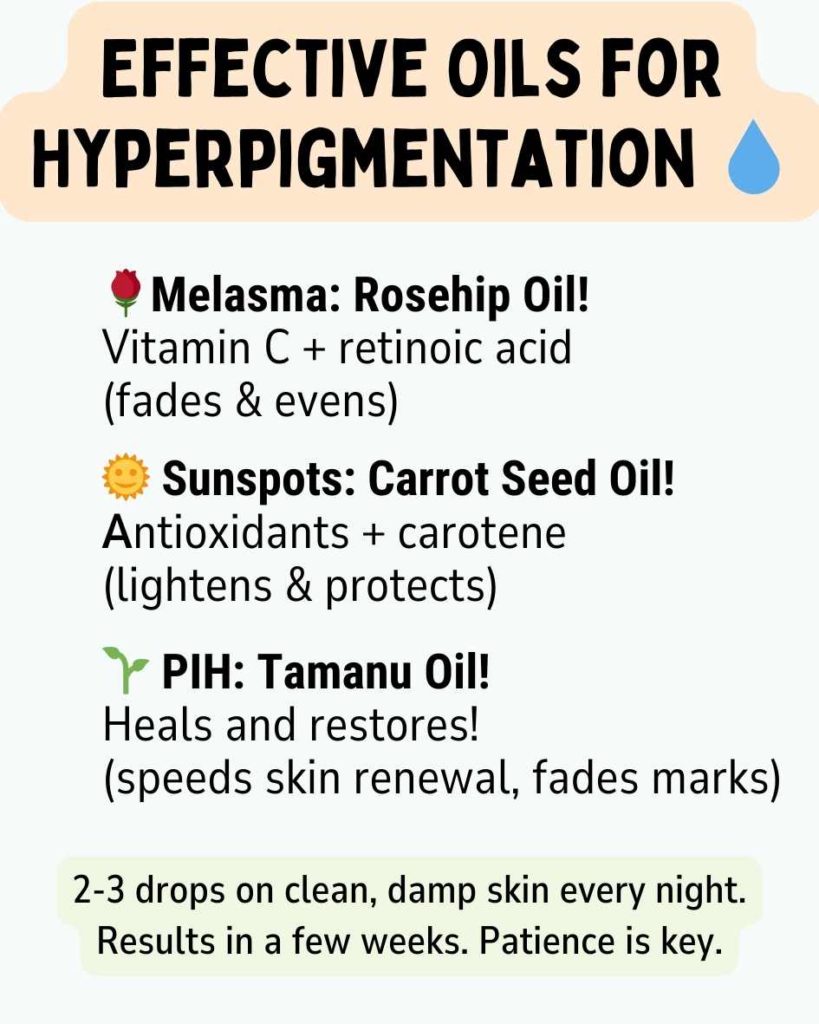
Do you know which type of hyperpigmentation do you have?
You might not be sure about which type of hyperpigmentation you have. The below is a very simple guide that can help you:
- Melasma: This is when you get uneven, brown patches on your skin, usually from hormonal changes, like during pregnancy.
- Sunspots: These appear from too much time in the sun. They’re small, dark spots that pop up on skin that’s seen a lot of daylight (<< this is the one I had).
- Post-Inflammatory Hyperpigmentation (PIH): These are the marks left behind after an acne breakout or an injury. It’s your skin’s response to inflammation.
Each has its own triggers and appears differently, but all can be addressed with targeted care and the right natural oils. Let’s introduce each one.
The magic of natural vegetable (also known as carrier) oils
Meet the 3 powerful oils in your fight against hyperpigmentation: rosehip, carrot seed oil and tamanu oil.
1) Rosehip oil for melasma (key components: vitamin C and retinoic acid)
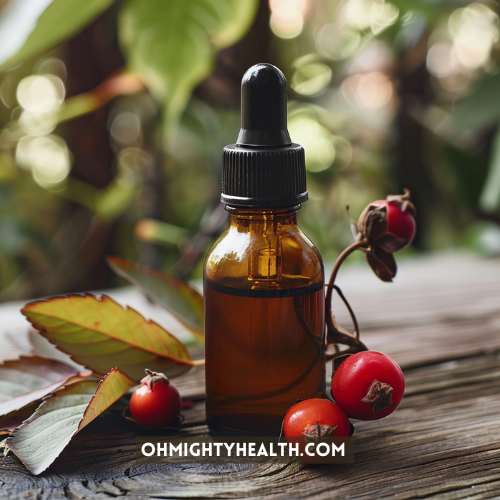
YOU CAN PURCHASE IT HERE.
Check the research here.
- It targets melasma: Full of vitamin C and natural retinol, it smooths out skin tone by speeding up skin renewal and fading the dark spots.
- Magic Ingredients: Vitamin C brightens your skin, and retinoic acid (a kind of vitamin A) helps get rid of old, dull skin and bring in the new. It’s like giving your skin a fresh start!
Vitamin C and natural retinol in rosehip oil play crucial roles in melanin regulation and skin cell renewal, directly addressing melasma’s uneven pigmentation. In other words, they help even out skin colour by creating fresh, healthy skin.
Other:
- Prevents acne: It’s also brilliant at keeping your skin clear, reducing the risk of acne flare-ups during treatment.
- Dual benefit: Not only does it lighten spots linked to melasma, but it deeply nourishes, making your skin glow and look younger (a wonderful oil for mature skin).
Note: Please, note that outcomes can vary! Even though it is a powerful natural remedy I can’t guarantee it will fix all melasma cases. 🙏
YOU CAN PURCHASE IT HERE.
2) Carrot seed for sunspots (key components: Beta-carotene, a type of vitamin A)

YOU CAN PURCHASE IT HERE.
Check the research here.
- It fades sunspots: Packed with antioxidants and vitamin A, it helps lighten those sun-loved areas by encouraging skin repair and reducing the visibility of sunspots.
- Magic ingredients: The beta carotene (a type of vitamin A) and other antioxidants in carrot seed oil are the secret sauce. They help fix sun damage and make your skin bright and even. It’s like a health boost for your skin that helps it bounce back from too much sun.
Carrot seed oil’s high levels of antioxidants and vitamin A protect against UV damage and stimulate skin repair, targeting the root cause of sunspots by encouraging the replacement of damaged cells with healthy ones. In other words, it’s like giving your skin a shield and tools to fix itself after too much sun.
Other:
- Sun protection: It offers a natural layer of protection against future sun damage, though it’s not a substitute for sunscreen!
- Revitalises your skin: Much like rosehip oil, it rejuvenates your skin, boosting overall health and giving you a vibrant, youthful look!
YOU CAN PURCHASE IT HERE.
3) Tamanu Oil for Post-Inflammatory Hyperpigmentation (PIH) (key components: Calophyllic acid and calophyllolide)
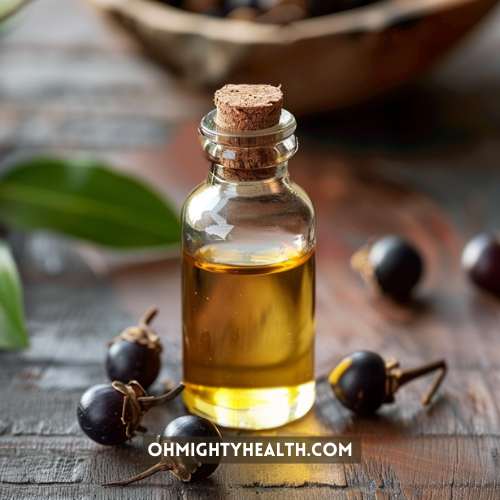
YOU CAN PURCHASE IT HERE.
Check the research here.
- It heals PIH: Rich in fatty acids and antioxidants, it speeds up the healing of scars and reduces the appearance of post-inflammatory marks.
- Magic ingredients: Calophyllic acid and calophyllolide stand out by speeding up skin repair and reducing inflammation, making them particularly effective for fading PIH.
The unique fatty acids and calophyllolide found in tamanu oil not only help to regenerate skin tissue but also possess anti-inflammatory properties that reduce swelling and redness, accelerating the healing process of PIH. In other words, it’s like a magic eraser for skin boo-boos, helping them disappear faster.
Other:
- Soothes the skin: Known for its anti-inflammatory properties, it calms irritation and redness, making it ideal for sensitive or inflamed skin.
- Promotes skin health: Thanks to its nourishing benefits, it tackles PIH and promotes healthier, more resilient skin.
YOU CAN PURCHASE IT HERE.
How to use the oils
Using these oils is easy-peasy, and you might just find them more effective than those pricey creams and serums. Here’s how to get started:
- Patch test first: Before going all in, do a small patch test on your arm. Wait 24 hours to make sure your skin says, “Yes, please!”
- Cleanse your skin: Always start with a clean face. This helps the oil soak in better.
- Apply a few drops: You don’t need loads. Just a few drops on your fingertips. Warm it by rubbing your fingers together.
- Gently massage: Pat or gently massage the oil onto your skin. Focus on areas with hyperpigmentation but don’t forget the rest of your face.
- Less is more: Start with once a day, preferably at night. Your skin does its heavy lifting while you snooze.
- Be patient: These things take time. Give it a few weeks to work its magic.
- Sunscreen is a must: If you’re using the oils in the morning, top it off with sunscreen. Some oils can make your skin more sensitive to the sun.
Remember, switching to oils doesn’t mean instant miracles. But with a bit of patience and consistency, you might just be surprised at how effective the oils can be.
What if I have more than one type?
If you’ve got more than one type of hyperpigmentation, no worries. It is normal to have a mix. Here’s how to handle it:
(A bit of trial and error, along with patience, will go a long way! You won’t overwhelm your skin.)
- Mix and match: It’s okay to use different oils for different concerns. For example, you might use rosehip oil on areas affected by melasma and dab some carrot seed oil on sunspots. Just keep each application to its targeted area.
- Layer wisely: If you’re keen on applying more than one oil to the same spot, start with the lightest oil first (like rosehip), let it absorb, and then apply a slightly heavier one (like tamanu oil) if needed.
- Consistency is key: Regular use is more important than using a lot at once. Stick to a routine, applying your chosen oils consistently over time.
- Listen to your skin: Pay attention to how your skin reacts. If it loves the combo, great! If not, you might need to adjust which oils you’re using or how you’re using them.
- Professional advice: When in doubt, a chat with a dermatologist can help tailor a routine that suits all your skin’s needs, especially if you’re dealing with severe hyperpigmentation.
Conclusion
My lovely readers, that’s all there is to it – simple, right?
I truly believe these oils could be the gentle, yet powerful, remedy your skin has been longing for.
Think of each drop as a tiny treasure. That’s certainly how I see it.
Patience, consistency, and a bit of love for your skin go a long way. Trust in nature. Trust in Mother Nature!
After all, she’s the one who brought us into this world. Imagine what else she can do?
For me, turning to natural oils is all about reconnecting with her, finding a bit of tranquility and healing in her embrace.
I’d love to hear about your experiences and successes. Please share your stories below.

